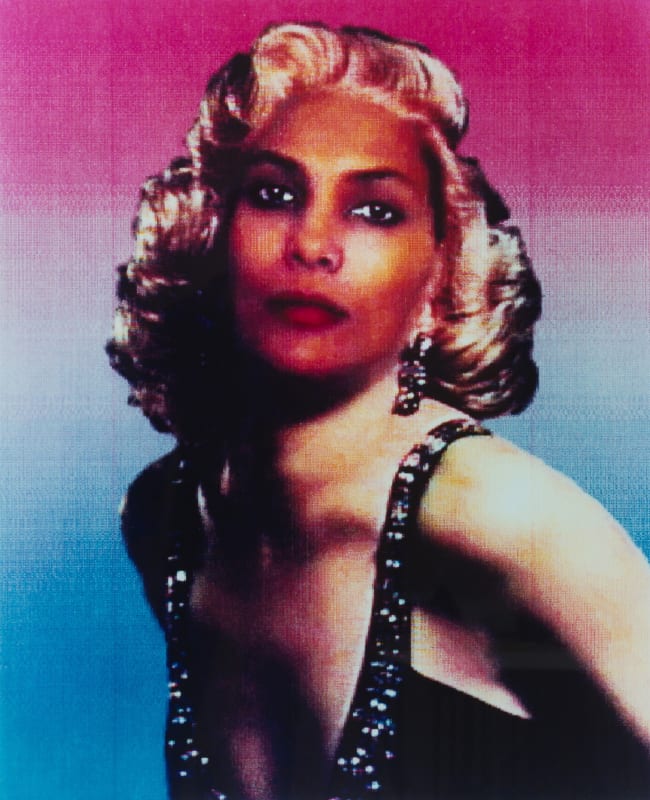Somerset House, London
Reflecting on the shocking representation of the ‘Hottentot Venus’ in the 19th century, 18 artists refocus the othering of Black women
Sarah Baartman was a South African woman who was enslaved and brought to London in 1810, where she was exhibited as a freakshow called the “Hottentot Venus” – Hottentot was the colonial term for Khoekhoe people, while Venus implied her exemplary exotic femininity. Put on stage as an object of scientific and sexual interest for European men, Baartman was paraded in public as “the missing link between man and beast”.
Reproductions of historical exhibit flyers depicting caricatures of Baartman and advertising these public displays of her body are the historical starting point for Black Venus, a new iteration of a touring exhibition curated by Aindrea Emelife, exploring how Black women make images of their bodies after a long and horrifying history of racism and objectification.
Some works confront the constructed image of the Hottentot Venus directly: Renee Cox takes on the role of Baartman in a large-scale black and white photograph, 1994’s Hott-en-tot, in which the American photographic artist poses wearing crudely oversized plastic breasts and buttocks on top of her own. Merging her own body with Baartman’s in an act of solidarity and pride, Cox gazes directly back at her own camera. The photograph evokes Baartman’s image but denies the viewer access to either Baartman’s body or her own, the inflexible fake body parts a costume and an armour against the gaze. Instead, the subject of ridicule is the grim opprobrium of European exploitation.
Baartman’s story is also preserved in a little-known suite of black and white nude self-portraits by the American artist Carla Williams made between 1987 and 1994. Small in scale but equally spectacular with their elegant, sumptuous sexuality, Williams’ assumes different eroticised poses, some inspired by images of Baartman. Her gaze is obscured or out of the frame, recalling the distant, anonymous archetypes of female figures in Greek or Roman sculptures – but here a subtle statement about agency and pleasure, and the right to self-objectification, to look at your own body through the lens of art history and claim a stake within it.
Though the exhibition focuses on photography and presents works made in the last 40 years, a preoccupation with 19th-century history persists throughout the exhibition, contesting the hypervisibility of the Hottentot Venus and the erasure in historical examples such as Thomas Stothard’s 1801 etching The Voyage of the Sable Venus from Angola to the West Indies – another linchpin of the exhibition. Based on Sandro Botticelli’s The Birth of Venus (1485 - 1486), Stothard’s reworking features an African woman – the “Sable Venus” – standing on a shell. She is being ferried by the Greek deity Triton, who waves a British flag, and a herd of white cherubim across the Atlantic. It is a deeply disturbing idealisation of the Middle Passage, used to support the transatlantic slave trade.
Confronting such representations is a rigorous and precise exercise in some of the works displayed. Using intensely detailed costumes and staging, Ayana V Jackson’s Anarcha, from the American artist’s 2017 series Intimate Justice in the Stolen Moment, reworks art historical depictions such as the Odalisque, common in 19th-century Orientalist painting. To counter the images of Black women’s bodies in the 19th century as mute, subservient or enslaved, Jackson embodies moments of reprieve, dignity and solace. In concert with these staged portraits are pieces from Maud Sulter’s 1989 Zabat series, which employ the conventions of Victorian portrait photography – stark black backgrounds and heavy gilt frames – to recast Black women as the Greek muses, such as the performance artist Delta Streete, posing as Terpsichore, the muse of dance.
Costume, pageantry and performativity are tools shared by many other artists shown here, aligning with feminist strategies in photography to examine gender, sex and beauty, but here also concerned with constructing intersectional narratives about Black women in the colonial era beyond the ethnographic, colonised and enslaved.
The exhibition does lean on a generation of renowned artists – such as Lorna Simpson, Carrie Mae Weems, Kara Walker and Zanele Muholi, well-known for their rich retelling of Black women’s stories and bodies – which feel like safe choices, rather than driving the conversation in new directions. Sparks fly when the works riff on the exhibition theme and broaden it out: for example, in the brightness and weightlessness of Ming Smith’s Instant Model (1976), a photograph of a passerby plucked from the crowd in Coney Island. It is a subtle but startling assertion of the extraordinary in the mundane, the possibility of beauty existing everywhere.

